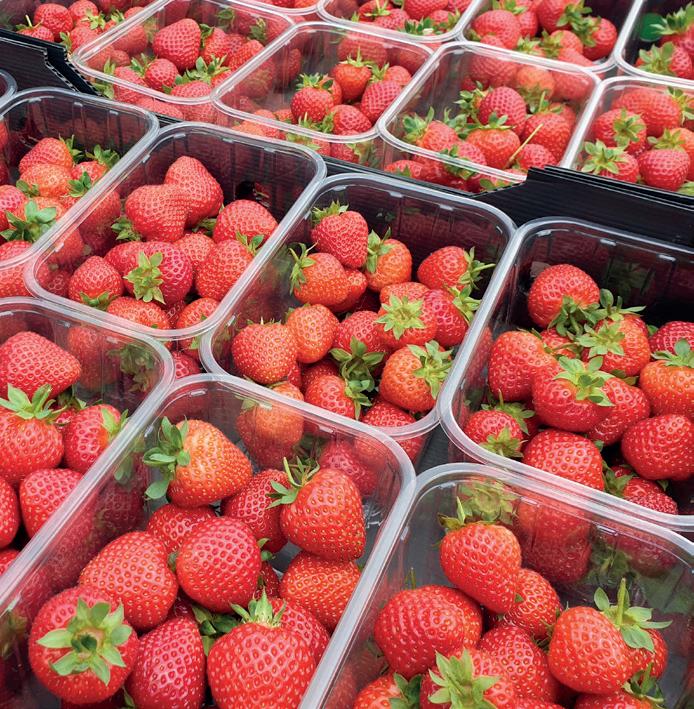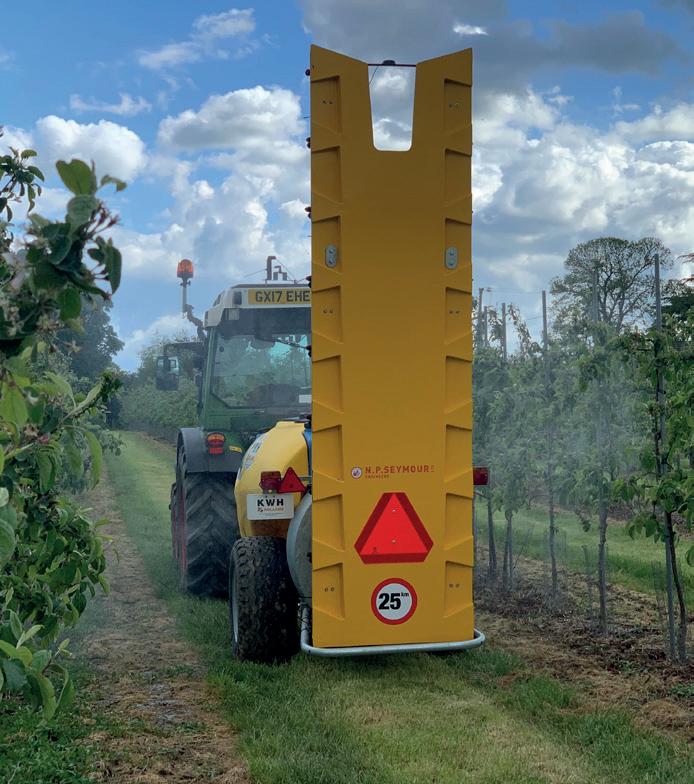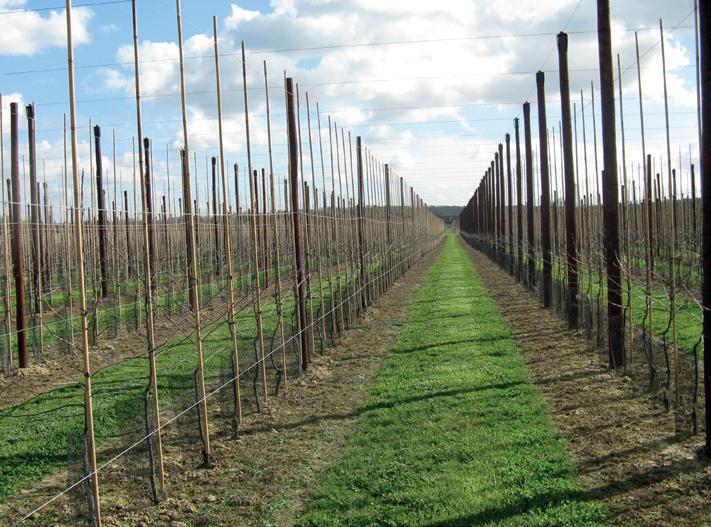
5 minute read
WET Centre technology delivers a new level of precision to soft fruit growers

Now in its seventh operating year, The Water Efficient Technologies (WET) Centre at East Malling is seen by many as NIAB’s beacon to lead growers to a new level of precision in their soft fruit production. Originally set up in 2017 to demonstrate NIAB’s water use efficiency research into practice for commercial growers, the Centre has now evolved and developed into an important research facility that investigates ways of optimising key resources and lowering emissions using novel approaches and, to increase precision, yields, fruit quality, and yield/harvest profiling.
Advertisement
Central to this pioneering work are the Centre’s funders, whose contributions enable the researchers at East Malling to use the very latest science and technology to find answers to questions that many would not have believed possible just a few years ago. Berry Gardens Growers Ltd, Cocogreen, Delta-T Devices and Netafim have been an integral part of the Centre since its inception, but more recently they have been joined by Stoller and Yara, along with two associate members, H L Hutchinson and Weatherquest, who all take an active role in shaping the work of the Centre and provide product knowledge and technical support each season. This industry support is, in turn, used to leverage funding from UKRI, particularly Innovate UK (IUK) funding.
With commercial growers typically irrigating their substrategrown strawberry crops to 15–25% run-off, some early work at the Centre demonstrated how growers could reduce their total water use each season by up to 33%, whilst maintaining the same yields and producing equal or higher quality berries (Figure 1). Combined with precision irrigation approaches, rainwater harvesting and re-use resulted in 90% water self-sufficiency in 2018, despite the very dry June and July in that year. The Centre has since compared reducing the level of run-off to 5% and 10%, without seeing any significant difference in yields between these levels, or any compromise in fruit quality.
Other early work demonstrated a 5% yield increase from white plastic Cocogreen bags in comparison to black bags, and current research is investigating the causes of this difference. The Centre was also used to demonstrate how the use of the powdery mildew risk prediction model, developed originally by NIAB at East Malling, could lead to a significant reduction in overall fungicide use on an everbearer strawberry variety.
A crucial feature of the WET Centre has been the division of the cropping into a ‘commercial area’, which mirrors typical commercial practice, and an ‘advanced area’ (Figure 2), which incorporates the latest technologies to more precisely control the phytoclimate. Not only can visitors to the site view this in action, but the scientists are able to make direct comparisons of fruit yield and quality between the two areas and report their results to the industry, allowing businesses to make informed decisions over whether to implement such technology on their own sites. The latest strawberry varieties being released by the East Malling Strawberry Breeding Club are also grown to demonstrate any advantages and shortcomings over existing industry standards.
Comparisons between the commercial and advanced areas in recent years have demonstrated significant differences in fruit yield using the everbearer Malling™ Champion. In 2020, Class 1 yield was found to be 5% higher in the commercial area, perhaps a result of the higher levels of shading in the advanced area, lowering the photosynthetically active radiation (PAR) at the canopy by 3-7%. It is thought that the increased steelwork associated with the roof vents in the advanced tunnels reduces light levels sufficiently to cause this yield difference, and this effect is probably exacerbated by the relatively large rainwater collection gutters. However, the more flexible venting control resulted in a 1°C reduction in temperature in June and July and up to 7°C in August 2020, and so the improved internal climate control from auto-venting could have significant benefits in hotter years.
Yield differences have also been recorded between seasons, with Class 1 yields of Malling™ Champion in 2021 being 22% lower than those recorded in 2020. The amount of accumulated light (photosynthetically active radiation – PAR) has been measured each season and the lower yields in 2021 could be attributed to lower light levels. The differing yields between the commercial and advanced areas, coupled with differing light levels, prompted the science team to start investigating whether differences in PAR were responsible for the variability in yields between individual rows in the advanced area. Our research so far has shown a strong correlation between light availability (PAR) and Class 1 yields, with the latter differing by as much as 12% in rows just 2 metres apart within one tunnel bay. This equates to a yield differential of over 11 tonnes per hectare.
There are six rows within each tunnel bay and further investigation revealed that the middle rows (2, 3, 4 and 5) were producing higher yields than the outer rows (1 and 6), with the highest yield being produced in Row 4. Using an array of precision environmental sensors manufactured by Delta-T Devices, a correlation was found between the highest yields per row and the amount of light reaching the canopy, so a comparison was made between Row 4 with Rows 1 and 6. Row 4 was found to receive 2 hours more PAR per day than Row 1, but strangely, despite both being outside “leg” rows, Row 1 produced higher yields than Row 6. We don’t yet know what is causing this result.
Like other plants, strawberry has a light saturation point, when photosynthesis plateaus, even with further increases in light levels. We discovered that the efficiency of photosynthesis is highest in Row 4 and also higher in the morning than in the afternoon. We are now testing if the higher-than-expected Class 1 yields in Row 1 could result from the peak in early morning PAR coinciding with the peak in photosynthetic efficiency. The results will inform our next steps to optimise the available light to each row at key times during the day using different techniques and technologies.
Work in 2020 also investigated the effects of a UV-blocking film, originally developed as a nonchemical way of reducing pest numbers, on leaf physiology, Class 1 yields, and berry quality. When compared to Malling™ Champion plants cropping under a clear film, Class 1 yields were reduced by 15% under the UV-blocking film; this was due to a reduction in fruit number as individual berry fresh weight was increased slightly, presumably due to the slightly cooler (1°C) air temperatures under the UV-blocking film. Again, the loss of yield was strongly correlated with a reduction in the cumulated PAR reaching the canopy. Leaf physiology was also changed, with stomatal conductance and photosynthesis being lowered, and while the former response reduced plant transpirational water loss, the latter resulted in a 0.5% fall in the average berry soluble solids content (° BRIX) over the season.
The knowledge gained by the WET Centre team on zonal phytoclimates within the tunnel also has enabled NIAB scientists at East Malling to work with one of our funders, Berry Gardens Growers Ltd, and colleagues at the University of Reading in an IUK project called ‘BerryPredictor’ to improve harvest forecasts, yield predictions and crop productivity, through the development of thermal time and PAR models.
Most recently, the Centre has expanded to include raspberry tunnels where we are currently growing Malling™ Bella for a Netafimled IUK-funded project (‘SmartFert’) on reducing fertiliser inputs and greenhouse gas emissions, using a combination of nitrogen-demand modelling, real-time NPK sensing and precision fertigation. We have also started to test new irrigation technology from Netafim to see if water and fertilisers can be distributed more evenly through the rootzone in a crop where Class 1 yield losses from inadequate fertigation scheduling are common.
The addition of Yara and Stoller to our funding consortium has enabled us to investigate the effects of some novel nutritional and biostimulant products in our commercial area. In 2022, we tested YaraVita’s ‘Actisil™’ and ‘BioNue’ products to assess the effect on yield, fruit quality and shelf-life in Malling™ Champion, along with an iron product’s effect on fruit quality. We also quantified the effects of Stoller’s products ‘Flower Power’ and ‘Green Forge’ in improving tolerance to, and recovery from, heat stress (a good year to do this!) along with their potential to improve yields, fruit quality and shelf-life. Another










